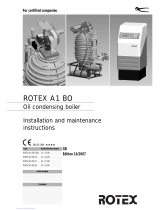
Fine sanding - eccentric motion
This position is selected for sanding
with low output for a scratch-free
surface (fine sanding).
Triangular sanding and pad change [4]
This position is used for sanding with
the delta sanding pad and slat sand
ing pad; the rotary motion is blocked.
You can change the sanding pad in
this position.
The stop rod [1-8] blocks the installa
tion of the sanding pad in the change-
over switch positions ROTEX rotary
motion and eccentric motion.
7.3 Changing sanding/polishing pad [5]
Only use sanding and polishing pads
that are suitable for the maximum
speed specified.
Tuned to the surface being processed, the ma
chine can be equipped with two sanding pads of
different hardnesses.
Hard: Coarse and fine sanding on surfaces.
Sanding edges.
Soft: Universal for coarse and fine sanding, for
flat and convex surfaces.
When the interface pad [1-12] is fitted on the
sanding pad, strength is reduced = extra soft.
► Following the sanding pad change, switch
the change-over switch [1-2] to the desired
sanding motion.
7.4 Changing sanding pad [6]
The delta sanding pad DSS-GE-STF-RO90 can
be used for sanding close to borders, in corners
or on edges. The slat sanding pad LSS-STF-
RO90 can be used for sanding in narrow gaps,
e.g. louvres.
Observe the following instructions:
Work in corners and on edges tends to subject
the tip to increased stress and results in in
creased heat development. In such cases, work
with reduced contact pressure.
Delta sanding pad DSS-GE-STF-RO90 [7]
If the front tip of the StickFix pad [7-1] of your
delta sanding pad is worn, take it off and turn it
120°.
Slat sanding pad LSS-STF-RO90 [8]
If the StickFix coating of the slat sanding pad is
worn, the complete table can be replaced. Open
the screws to do this [8-1].
7.5 Attaching sanding accessories
The suitable StickFix sandpaper and StickFix
sanding cloth can be attached quickly and sim
ply to the StickFix sanding pad.
► Press the self-adhesive sanding accessory
onto the sanding pad [1-7].
7.6 Attaching polishing accessories
To prevent damage, PoliStick accessories (pol
ishing sponges, polishing felt, sheepskin) must
only be used on the special polishing pad.
► Press the self-adhesive polishing accessory
onto the sanding pad [1-9].
7.7 Dust extraction
WARNING
Dust hazard
► Dust can be hazardous to health. Always
work with a dust extractor.
► Always read applicable national regula
tions before extracting hazardous dust.
At the extractor connector [1-5], a Festool mo
bile dust extractor with an extraction hose di
ameter of 27 mm can be connected.
Recommendation: Use an antistatic extractor
hose. This helps reduce the electric charge.
7.8 Edge protector [9]
The edge protector [1-1] reduces contact of the
sanding pad circumference with a surface (e.g.
when sanding along a wall or a window), thus
preventing back-kick of the machine, or ma
chine damage.
8 Working with the machine
WARNING
Risk of injury
► Always secure the workpiece in such a
manner that it cannot move while being
machined.
Observe the following instructions:
– Do not overload the machine by pressing
with excessive force! The best sanding re
sults are achieved with moderate applica
tion pressure. The sanding capacity and
quality are mainly dependent on the selec
tion of the correct abrasive.
English
16








